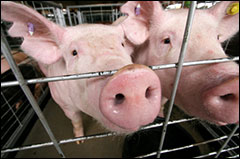Dear Umbra,
Commercial pork production is a nasty, polluting operation and inhumane to the animals. What makes organic pork different? Simply what they are fed, or does it involve more humane and less polluting production operations?
Related, I have been purchasing free-range, organic chicken for several years now. However, recently the free-range, organic chicken breasts have been humongous, conjuring up images of Dolly Parton chickens toppling over in their pecking yard. What’s up? Any thoughts?
Puzzling over the universe,
Pat
Emeryville, Calif.
Dearest Pat,
Another column of little interest to vegetarians.
I’m afraid I don’t have the time or space to dive into your evocative chicken question at the moment. For today, let’s stick with pork.

Bound for gory.
Photo: iStockphoto
I want you to know that the United States is a “major player in the world pork market,” according to the proud USDA. Somehow we are both the second-largest exporter and importer of pork “products.” The character of pork production in this country lends these rankings a nauseating quality. Two of the infamous aspects of the confined animal feeding operations that lead to pork “products” are keeping pregnant sows in immobilizing crates and creating giant lagoons of pig effluent.
Within this profit-driven pork universe diversity still exists, and its general name is “niche pork” — there’s even a website. Small and mid-scale pig farmers can stay afloat by establishing their product niche with animals that are culinarily or ethically improved over CAFO pork — or both. Organic certification is one aspect of niche pork, but not the only one.
The National Organic Program rules for animals consists of generalized guidelines about feed (must be organic), antibiotics and growth hormones (unallowed) and lifestyle (animals must have outdoor access). These rules do not guarantee that a pig has experienced any piggy fun such as snorfelling merrily through the grass, making its own bed from straw, biting its farmer, or staying far from its own excrement. It is possible to meet the organic guidelines, and pass the yearly inspection, but still run a variant of a confinement operation.
You know I support organic, but a system that has in large part become simple object substitution (hello, organic whipped cream in a can) can no longer be unexamined.
Other niche pork producers may use a different certification to get the message out to consumers. Certifiers such as the Food Alliance and the Animal Welfare Institute (two out of many) have set their own guidelines for farmers, which you actually may prefer over the organic label. The AWI standards are completely focused on animal welfare; the Food Alliance includes treatment of farmworkers as well. USDA-overseen claims such as free range, antibiotic-free, etc., are also found in stores.
As usual, for organic it’s best to get an idea of the individual producer’s habits by talking with your grocer, visiting the farm, or surfing the web, where indications of the size of the operation could be a tip-off. And as with other foods we’ve discussed, you can also try to find a pork farmer and get to know their operation, satisfying yourself with a personal connection.
In addition to finding niche pork, you may want to change your eating habits: one reason indoor confinement and gruesome farrowing (birthing) systems exist is to satisfy a consumer desire for pork on demand. Pigs farrowing more naturally, or in the out of doors, only do so during clement weather from spring to fall, so there isn’t a year-round supply of pork. If you find a small producer, you will have to acclimate your porky habits and meet the system halfway.
Poor pigs. A bit of special jargon to leave you with: a female pig that has never been pregnant is called a gilt.
Boarily,
Umbra


